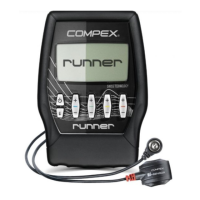10
English
III HOW DOES ELECTROSTIMULATION
WORK?
The principle of electrostimulation is to
stimulate nerve bres by means of electrical
impulses transmitted by electrodes.
The electrical pulses generated by Compex
stimulators are high quality pulses - oering
safety, comfort and eciency - which can
stimulate dierent types of nerve bres:
1. the motor nerves, to stimulate a muscular
response. The quantity and the benets
obtained depend on the stimulation
parameters and this is known as electro-
muscular stimulation (EMS).
2. certain types of sensitive nerve bres to
obtain analgesic or pain-relieving eects.
1. Motor nerve stimulation (EMS)
In voluntary activity, the order for muscular
work comes from the brain, which sends a
command to the nerve bres in the form
of an electrical signal. This signal is then
transmitted to the muscular bres, which
contract.
The principle of electrostimulation
accurately reproduces the process
observed during a voluntary contraction.
The stimulator sends an electrical current
impulse to the nerve bres, exciting them.
This excitation is then transmitted to the
muscular bres causing a basic mechanical
response (= muscular twitch). The latter
constitutes the basic requirement for
muscular contraction. This muscular
response is completely identical to
muscular work controlled by the brain. In
other words, the muscle cannot distinguish
whether the command comes from the
brain or from the stimulator.
The parameters of the Compex
programmes (number of impulses per
second, contraction time, rest time, total
programme time) subject the muscles
to dierent types of work, according to
muscular bres. In fact, dierent types
of muscular bres may be distinguished
according to their respective contraction
speed: slow, intermediate and fast bres.
Fast bres will obviously predominate in a
sprinter, while a marathon runner will have
more slow bres.
With a good knowledge of human
physiology and a perfect mastery of the
stimulation parameters of the various
programmes, muscular work can be
directed very precisely towards the desired
goal (muscular reinforcement, increased
blood ow, rming up, etc.).
2. Stimulation of the sensitive
nerves
The electrical impulses can also excite the
sensitive nerve bres to obtain an analgesic
or pain-relieving eect.
The stimulation of the tactile sensitive
nerve bres blocks the transmission of pain
by the nervous system. The stimulation of
another type of sensitive bres creates an
increase in the production of endorphins
and, therefore, a reduction of pain.
With pain relief programmes,
electrostimulation can be used to treat
localised sharp or chronic pains as well as
muscular pains.
Caution: Do not use the pain relief programmes
for a long period without medical advice.
Electrical
pulse
Motor
nerve
Stimulated
muscle
Transmission
of the excitation
Excitation
Elementary mechanical response - twitch

